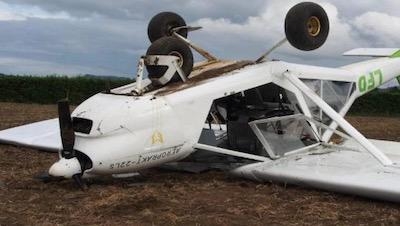Wed, Apr 03, 2019
Prolonged Exposure To UV Rays Caused The Windscreen On Rod Vaughan's Aircraft To Fail
On March 29, 2018, a pilot and passenger departed Thames Aerodrome near the Firth of Thames in New Zealand for a scenic flight to the east coast. Having been flying for approximately 40 minutes, heading back to Thames Aerodrome, the pilot flew the aircraft over the open mine to the north of the town of Waihi. While both occupants were viewing the open mine at approximately 1600 feet above mean sea level, and at a speed of 80 knots, the windscreen failed catastrophically.

The aircraft, an Aeroprakt 22-LS, was being flown by journalist Rod Vaughan. His son was also on board the airplane, according to News Hub.
The sudden inflow of air caused both cabin doors to come open and aerodynamic control became compromised. The pilot elected to make a forced landing onto open ground to the south of the town. While a successful approach was made to the chosen farm paddock, following touch down the aircraft bounced and was inverted, injuring the occupants. Emergency services attend and provided assistance.
When interviewed regarding the incident, Vaughan reported a possible collision with a drone. Examination of the aircraft and searches of the area of the mine have found no evidence of a drone.
During the examination of the aircraft it was found that there was discolouration of the plastic polymer windscreen in the form of yellowing from original clear. Subsequent laboratory examination of recovered chards and sections from the windscreen, identified evidence of Ultra Violet (UV) degradation to the upper areas of the exterior surface. UV degradation can affect the polymer bonding properties which can result in sudden failures.
Due to the high UV levels in New Zealand that can adversely degraded plastic polymers, it is recommended that aircraft are stored in a suitable building or a material cover is placed over the windows. Thorough pre-flight inspections could identify the emergence of discolouration or other defects of the aircraft transparencies. The use of cleaning materials should also be carried out in accordance with the manufacture’s requirements. Any defects noted should be discussed with a suitably qualified maintenance provider.
(Image courtesy NZ police and CAA)
More News
Klyde Wonders If The 'New' SouthWest Can 'Out-Spirit' Spirit... FMI: www.klydemorris.com>[...]
From 2012 (YouTube Edition): Extensive Expertise in Backup Solutions Makes MCIA Uniquely Qualified In This Market There's no such thing, in aviation, as TOO much caution... hence t>[...]
Aero Linx: Historic Aircraft Association (HAA) The Historic Aircraft Association (HAA) was founded in 1979 with the aim of furthering the safe flying of historic aircraft in the UK>[...]
Jamming Denotes emissions that do not mimic Global Navigation Satellite System (GNSS) signals (e.g., GPS and WAAS), but rather interfere with the civil receiver's ability to acquir>[...]
"Respectfully, U.S. and European airlines should not be even contemplating the future purchase of airplanes from Chinese military companies...” Source: US Representative Raja>[...]
 Klyde Morris (05.02.25)
Klyde Morris (05.02.25) Classic Aero-TV: Introducing The MD302--Mid-Continent's Standby Attitude Module
Classic Aero-TV: Introducing The MD302--Mid-Continent's Standby Attitude Module ANN's Daily Aero-Linx (05.04.25)
ANN's Daily Aero-Linx (05.04.25) ANN's Daily Aero-Term (05.04.25): Jamming
ANN's Daily Aero-Term (05.04.25): Jamming Aero-News: Quote of the Day (05.04.25)
Aero-News: Quote of the Day (05.04.25)



